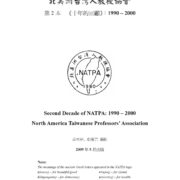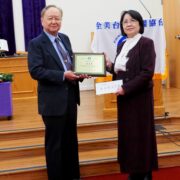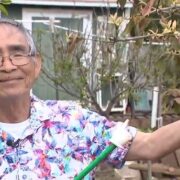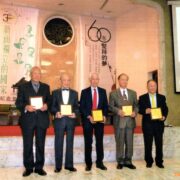History of the North America Taiwanese Professors’ Association
Author: Shutsung Liao
The North American Taiwanese Professors’ Association (NATPA) was established with the goal of caring for Taiwan’s democracy and welfare, and to speak out for Taiwan. NATPA was formally established in 1980, and it was among the earliest organizations that were established by overseas Taiwanese people. Before this, Taiwanese organizations were scattered across the United States, and due to the illegality of holding private political activities, many kinds of meetings had to be held secretly, restricting the mobility of participants. Thus, experts from various different locations were never able to assemble and communicate with one another. NATPA was the first Taiwanese organization to use a democratic voting system to elect its leaders, and I am one of its founding members and the first president of the association.
NATPA’s establishment can be traced to 1975. One October night that year, a number of Taiwanese professors teaching in the Midwest gathered at my humble home. We discussed issues like Taiwan’s political and social conditions, the establishment of diplomatic relations between China and the United States, and the future of Taiwan. We arrived at the topic of needing to form an organization that could bring together Taiwanese scholars and specialists from around North America to strengthen interchanges, teamwork, mutual support, and cooperation between us, in order to work hard to make Taiwan into a democratic and prosperous new country. In the following years, this consensus continued to linger in people’s minds.
On December 10th, 1979, the Formosa Incident occurred in Kaohsiung. Tangwai (“outside the party”) figures held an International Human Rights memorial parade, but there were undercover agents that the Kuomintang sent to infiltrate the demonstrators and start riots. On December 13th, the Garrison Command arrested 14 people involved in the Formosa Incident on suspicion of “rebellion.” These 14 people included Chang Chun-hung, Yao Chia-wen, Wang Tuoh, Chen Chu, Chou Ping-te, Su Chiu-cheng, Annette Lu, Chi Wan-sheng, Lin Yi-hsiung, Chen Chung-hsin, Yang Ching-chu, Chiu I-pin, Wei Ting-chao, and Shih Ming-teh, who was wanted. The Formosa Magazine headquarters in Taipei and its various offices were call closed down. On December 14th, the publisher of Formosa Magazine, Huang Hsin-chieh, was arrested by the Garrison Command with the full support of all the “thousand-year legislators” in the Legislative Yuan. Later, Lin Hung-I, Shih Ming-teh, Tsai Yu-chuan, and Kao Chun-ming were also arrested.
After the Formosa Incident, 137 Taiwanese professors and experienced scholars from over 60 different universities and well-known research institutions jointly issued a statement in the Washington Post that strongly protested against the Kuomintang government’s use of the Formosa Incident as an excuse to make massive arrests of Tangwai democratic figures, human rights activists, peoples’ representatives, and religious figures. This incident increased the immediacy of our need to form an organization for North America’s Taiwanese professors and scholars. Thus, at the end of December, a number of Taiwanese professors and scholars from California collectively proposed that we create the North America Taiwanese Professors’ Association. And so, preparatory activities began, unfolding quickly like a raging fire.
The Formosa Incident was a turning point in the history of the Taiwan democratic movement. Though the older generation of the opposition movement were all imprisoned, the young lawyers of the law firms that had defended them had been heavily influenced by their actions. These individuals devoted themselves to the opposition movement, and became a new generation of leaders who, after the political party rotation, became Taiwan’s political leaders. The defendants and their defense lawyers are as listed: Huang Hsin-chieh (Chen Shui-bian, Cheng Ching-lung), Shih Ming-teh (Cheng Sheng-chu, You Ching), Chang Chun-hung (You Ching, Kuo Chi-ren), Yao Chia-wen (Frank Hsieh, Su Tseng-cheng), Lin Yi-hsiung (Chiang Peng-chien, Chang Cheng-hsiung), Annette Lu (Lu Chuan-sheng, Cheng Kuan-li), Chen Chu (Kao Rui-cheng, Chang Huo-yuan), Lin Hung-hsuan (Chang Chun-hsiung, Li Sheng-hsiung).
Taiwan’s opposition movement has been advancing for centuries, and with the spirit of “sweet potatoes are not afraid of dropping on the ground and rotting, they only hope that they will have branches and leaves for many more generations,” the people of the movement have inherited their past and carried it into the future. Overseas Taiwanese professors and scholars hoped that when the situation in Taiwan changed, they would be able to contribute their strength and unite the masses to help the Taiwanese people, both at home and abroad, Taiwanese society, and its democratic reforms. All this contributed to the establishment of the North America Taiwanese Professors’ Association, which has had a very strong and far-reaching impact on Taiwanese people living on the island, in the United States, and in Canada.
On February 16th, 1980, the first preparatory meeting was held at the international dorm at the University of Chicago. Sixteen professors attended the meeting, including myself, Chin-che Chang, Parris Hsu-Cheng Chang, Ping-chi Chen, Yuan-cheng Huang, Kim Lai Huang, Robert Y. Lai, Chin-Chu Lin, Chin-Teh Sun, Wen-Yih Sun, Edward Gibin Tanng, Chia-yin Tsai, De-Min Wu, Kenneth K. Wu, Sheng-liang Yang, and Wen-liang Yen. During the meeting, we discussed the drafting of the organizational charter, and I was selected as the interim President, responsible for preparing for the establishment of the organization. It was also decided that the professors’ association should hold meetings in Taiwan and use the results of their research to give back to Taiwan and serve our countrymen.
On February 28th of the same year, a murder occurred at Lin Yi-hsiung’s home. His mother, Yu A-mei, and two 7-year-old twin daughters, Lin Liang-chun and Lin Ting-chun were killed, and his 9-year-old daughter, Lin Huan-chun (Judy Linton), was seriously injured. The murderer’s cruelty truly cannot be paralleled; it was truly awful. At that time, Mrs. Lin had been visiting Xindian Military prison where Lin Yi-hsiung was being detained. Moreover, since the National Security Bureau had put the Lin residence under 24-hour monitoring, many people thought that this was a deliberate political murder. The incident occurred on the 33rd anniversary of the 228 Incident.
After the professor’s association preparatory committee received a telegram from Taiwan, I immediately sent a statement of harsh protest to the Republic of China Consulate General in Chicago. I also contacted other Taiwanese associations in North America and American governmental agencies. At the time, the consulate had not yet received the news, and so they did not believe that the incident had really occurred. One hour later, they called me to acknowledge the truth, and expressed that they were surprised by the efficiency of communication between Taiwanese groups.
On April 24th, the association was officially established and named the North America Taiwanese Professors’ Association (NATPA), and it was registered as a non-profit corporation with the state of Illinois. On June 7th, 1983, the U.S. federal government’s Internal Revenue Service certified NATPA as a non-profit, tax-exempt organization.
NATPA has continued to be concerned about the Lin Family Massacre, and we have continued to stay in contact with Lin Yi-hsiung and his family through his imprisonment and after his release. NATPA also supported his later studies at Harvard University in the U.S., University of Tsukuba in Japan, and the University of Cambridge in the U.K.
On August 9th, 1980, NAPTA held its inaugural meeting in a conference room in the University of Chicago Ben May Department for Cancer Research. Over forty members from around North America attended the meeting. During the meeting, the charter and bylaws were formally adopted. We cleared outlined the association’s four missions: (1) enhance scientific expertise and knowledge and their practical usage; (2) promote international educational and cultural exchanges with Taiwan; (3) support research on Taiwan-related issues; (4) promote and maintain justice and welfare for the Taiwanese people. Three work goals were also established: (1) strengthening and expanding the organization, which includes recruiting members, creating local chapters, and finding Taiwanese people with technical expertise and other human resources; (2) contacting other organizations and governmental agencies, which includes cooperating with and contacting other Taiwanese American organizations, and both public and private, social, cultural, and educational organizations in the U.S. and abroad; (3) giving back to our homeland, which includes promoting the democratization of Taiwan, protecting social justice and human rights, and assisting with or providing the expertise and skills needed to establish a prosperous Taiwan. These decisions determined the goals and direction for NATPA.
During the meeting, four Regional Directors and five General Directors were selected. The Regional Directors were Parris Hsu-Cheng Chang of the Eastern Region, David Tsay of the Northern Region, Fu-Mei Chang of the Western Region, and myself of the Midwestern Region. The General Directors were Kim Lai Huang, De-Min Wu, C. Y. Tsai, Ping-chi Chen, and Robert Y. Lai. The council selected me as its first president, and Edward Gibin Tanng was put in charge of secretarial and financial management duties. Additionally, we established committees to manage research, publication, finance, and membership, and established that the Presidency would last for one year. After the political party rotation in 2000, Directors Fu-mei Chang and Parris Hsu-Cheng Chang returned to Taiwan. Fu-Mei Chang served as the Minister of the Overseas Community Affairs Council, and Parris Hsu-Cheng Chang served as a Democratic Progressive Party legislator and the Deputy Secretary-General of the National Security Council.
After NATPA was established, it began actively intervening into issues regarding Taiwan’s development. At the time, Taiwan’s economy was growing rapidly with the accelerating development of a variety of different industries, and nuclear power plants were introduced to help meet electricity demands. NATPA contacted the Washington D.C. Nuclear Regulatory Commission and Policy Development Center and was surprised to learn that the Kuomintang government planned to spend billions of U.S. dollars to buy nuclear energy equipment that have already been prohibited in the States. NATPA urged Kuomintang authorities not to develop nuclear power plants without carefully assessing the safety of nuclear energy and the long-term impacts it could have on the local residents and environment. This statement was written in English and Mandarin, and it called on people both at home and abroad to come together to resolve this issue. Additionally, since NATPA has a number of experts in nuclear energy involved in relevant U.S. agencies, they were able to assist in training the individuals responsible for handling Taiwan’s nuclear accidents. For a long time, Taiwan was a region with a very high prevalence of Hepatitis B infections. In 1980, Merck Sharp pharmaceutical company and the New York Blood Center planned to test their vaccines in Taiwan, but there was strong backlash because it was still unclear whether the vaccines were safe. I directly contacted Dr. Maurice R. Hilleman, who was formerly employed by the University of Chicago and was in charge of the Merck Sharp Taiwan trials, to discuss the quality and danger of the vaccines. I also collected relevant medical reports for Taiwan’s reference. In the end, this vaccine testing plan, the safety of which was still unknown, was ultimately cancelled. After this, however, the Kuomintang government immediately introduced a French vaccine that was still being tested.
In 1981, NATPA hosted the Taiwanese American Conference – East Coast and their annual meeting in cooperation with the Taiwanese Association of America from July 2nd to July 5th. Since then, NATPA has frequently co-organized its annual meeting with the four major Taiwanese American Conferences – East Coast, West Coast, Midwest, and South. At the 1981 annual meeting, Yao-rung Chen (Eastern Region), Chin-Teh Sun (Midwestern Region), Wen-Hsiung Li (Southern Region), and Wylie Lee (Western Region) were selected as the new Regional Directors. This new Board of Directors elected C. Y. Tsai as the second presented, and his term began on August 1st. The Board also decided to establish its headquarters in Illinois, and they asked me to become the Executive Director of the headquarters office. The headquarters’ main tasks are to (1) be responsible for external communication and negotiations; (2) assist each president with their work; (3) hold responsibility for making tax and other reports to the federal and local governments; (4) do research and provide support as the organization’s headquarters. To this day, I am still doing my best for NATPA’s headquarters.
※Reference material: First Decade of NATPA Book
Sourced from Eating Fruit, Worshipping the Tree – Memories from Shutsung Liao’s Life
Translated from 69. 北美洲台灣人教授協會/廖述宗/2014/12





